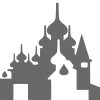The arrangement of the Kizhi churches as an example of the inside design of a northern orthodox church
 @kizhi
@kizhi
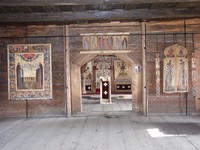
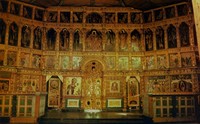
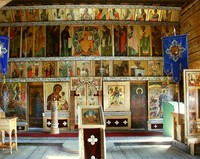
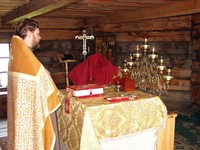
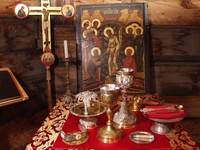
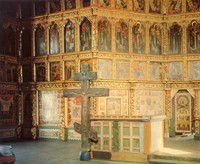
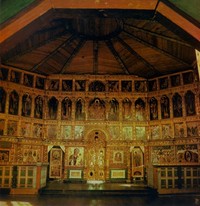
The first Orthodox churches appeared in Obonezhie with spreading of Christianity, which took place rather late. The development of the churches adornments had changed its styles with centuries. Some specific features of the interior design resulted from the fact that before the 19 th century the majority of the churches in Obonezhie were made of wood and the ecclesiastic sites had a summer church and a winter church. Let’s take as an example the interior of the churches of the Kizhi Pogost of Our Savior, which has always consisted of the winter church of the Intercession, and the summer church of the Transfiguration.
Church is a structure built and trimmed in a certain way for gathering of congregation.It is a place for alliance of people and God through sacraments and prayers. Services include reading prayers, Scriptures, singing psalms and hymns, sequent development of action involving priests and congregation as well as a certain sacrament depending on the type of a service. The architecture of a church, the symbolism of the interior, the adornment of the church and attire of a priest, and illuminators and ecclesiastical ornaments are linked with a service. The interior of a church developed together with the development of the ecclesiastical cannons. As a result, liturgical symbolism defined the so-called «topographic symbolism» of a church interior with the idea of «a church as ascent to heaven» in the center [1] .
The west-east orientation explains three parts of the church interior (narthex – church proper – alter). This division symbolizes ascent from «worldliness life» to «spirituality» to «heaven» [2] where the action is concentrated on a chancel table and through it on liturgy.
The Karelian Orthodox churches consist of these three main parts.
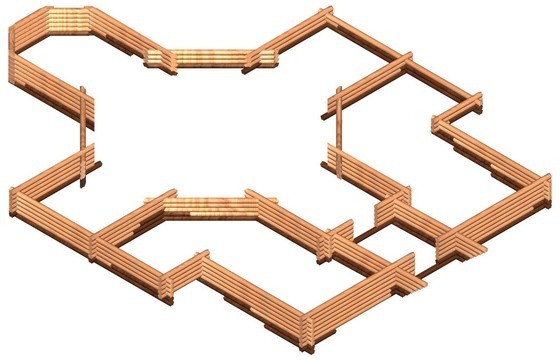 The plan of the Church of the Transfiguration on the Kizhi island.
The plan of the Church of the Transfiguration on the Kizhi island.In a winter church these three parts are preceded by a passage, which is due to the local climate. The passage is separated from the narthex (called «refectory» in European North) by a solid wall with a door that was an additional protection against cold wind and frost. The passage interior was modest – benches and some icons above the entrance.
In the winter Church of the Transfiguration there were 6 icons enlisted:
- «Our Savior»,
- «The Virgin»,
- «The Archangel Michael»,
- «The Archangel Gabriel»,
- «St. Nicholas»,
- «The Reverend Varlaam of Khutyn» [3] .
The next part of a northern wooden church is a narthex. Usually it was a separate room, which was used both for church and secular needs that were interrelated. Here birth, deaths and marriages were registered [4] .
There were necessary ornaments including candle box for those rites as well as several icons there. The number of icons was different in different churches. The narthexes of a winter churches was heated by stoves.[текст с сайта музея-заповедника "Кижи": http://kizhi.karelia.ru]
There had been the aisle in honor of St. Nicholas in the Kizhi Church of the Intercession since its construction approximately in 1695.Being the main part of the church it has an iconostasis, cantorisis and it was used for services. So till 1865 when because of scare space the aisle was removed due to the bids of the congregation, this part was both the church and narthex.
The next part of the church is a church proper. This part concentrated most of the ornaments. The church adornment was to match the services.
Here there could be both a few and many icons. As a rule they were of different subject – matter as they had been collected in the process of the parish life. Some of them were donated; others were removed here from the iconostasis due to its renovation or alteration in its arrangement.
In the center there was a table with a sloping top – an alter stand for an icon, which corresponded by the subject-matter either to the day of a service or to a current month [5] . The Kizhi churches also had a set of 12 icons with the images of the holy days and the saints for each month. The alter stand was clad either with everyday or special cloth.It is worth noting that the cloths for an alter stand, credence table and holy table were often made of cloth donated by the congregation. Some documents state that women gave their expensive dresses for church needs.It took so much cloth to make a broad female dresses that it was enough to sew church attires.
In the Kizhi churches there was an elevated platform in the eastern part of the church proper.From both sides of the platform there were stands for quire and epistlers. According to the inventory of 1865, there were monthly icons behind the right stand of the Church of the Intercession in Kizhi [6] . On the stands there were banners and a lantern to be used for sacred processions. The platform in the Church of the Transfiguration was so big that it was easy to place two grand icon arks decorated with carving, gilding and sculpture near the stands. One of them contained the icon of «Savior the Merciful», the other – the icon of «Dormition».[текст с сайта музея-заповедника "Кижи": http://kizhi.karelia.ru]
In orthodox churches of the Russian North, the iconostasis on the eastern wall concentrated most of the icons and ornaments. The tiers of icons completely covered the eastern wall behind which there was the third part of a church – alter.
Iconostasis of the Obonezhie churches were of two types: tyablo one and framed ones. Tyablo iconostasis were more archaic [7] . Tyablos were usually made of beams with groovings to fix icons. The front of the tyabloes had a foundation made of lime and glue dissolved in warm water and painted or covered with texts (for example a tyablo of one of the chapels of Kizhi parish had a text describing the construction of the chapel). This type of the iconostasis had been common for a long time and it was associated with «Old Russ».
Since the 17 th century (later in the European North) a more complex type – framed iconostasis – began to develop. This kind had both horizontal and vertical arrangement. Here one icon was separated from another by gilded wood carving with the main motif of grapevine as the symbol of Church and Communion from early Christianity.
At the end of the 17 th century and in the 18 th century, under the influence of the baroque style the carved design of the local iconostasis became more sophisticated due to architectural forms – columns, pilasters, architraves, and cornices. The gilded carved iconostasis is preserved in the Kizhi Church of the Transfiguration but now it is dismantled and its parts are stored in the storage facilities of the Kizhi museum.
The Kizhi Church of the Intercession originally had a tyablo iconostasis. The traces of its installation can still be seen in the sidewalls. Later the tyablo iconostasis was replaced with more fashionable one with carved pilasters and cornices with gilding and imitation of marble. While restoring the church for museum use A. V. Opolovnikov, the chief designer of the restoration, reconstructed a tyablo iconostasis.[текст с сайта музея-заповедника "Кижи": http://kizhi.karelia.ru]
The oldest descriptions of the local iconostasis recorded different number of tiers. The iconostases in the Kizhi churches have always included four tiers of icons.
An iconostasis is «a border between temporal and eternal», which separates the praying room from «holy of the holiest» of an Orthodox church – its alter – the third and most sacred part of a church.
Sacraments symbolize Christ’s presence in a church. Liturgy is the culmination of everything that takes place here. The liturgy is concentrated on the sacrament of Eucharist or thanksgiving. The Eucharist is performed on a consecrated credence table and holy table covered with cloth. Vessels and items necessary for the liturgy are placed on the tables.
Gradually in addition to the items enlisted above some others appeared in the alter: an icon and a lantern to be carried out, and icons on the walls. If there was no vestry the cloths were stored in a wardrobe or chest of drawers in the alter [8] .
One of the main differences on an Orthodox church from churches of other confessions is in the fact that the iconostasis completely covered the eastern wall. Creative search resulted in interpreting an iconostasis as light border having very important symbolic information, which evidently stimulated the aspiration for its maximum dematerialization. As a result the iconostasis has developed in a single huge panel architectonically related to a big icon with marginal scenes and the image of Savior in the center [9] .[текст с сайта музея-заповедника "Кижи": http://kizhi.karelia.ru]
The logical pattern and entirety of the iconostasis was achieved by following the same heights and widths of icons in tiers and the different heights of the tiers. This grand iconostasis arrangement is achieved by certain location of the icons. They were arranged into tiers according to a certain strict system. Each tier had its own name.
The number of the tiers in the iconostasis of the Church of the Intercession was typical for northern churches. Although the number of tiers of the iconostasis in the Church of the Transfiguration was traditional in its size and ideas, as well as the number of icons were impressive.
The lower «Local» tier of the iconostasis differs from other tiers not only in variety but also in the size of the icons. This tier contains icons painted in the 17 th and early 18 th centuries. They are of different size and to have the single height of the tier they are framed. The frames have depictions, which help to reveal the image. There are many such icons in the local tier of the Church of Transfiguration. For example, the minor icon «The Vernicle» has a frame with the depiction of the story of the image of Christ’s face printed on the head cloth. The frame of «The Transfiguration icon» has scenes of Holy Passion. Catalog of icons of the local tier of the iconostasis from the Church of the Transfiguration.
There are the carved Royal Gates with small round frames where 7 small icons were put (only one with the image of the evangelist John has been preserved). Six of them depicting the Annunciation and the evangelists were placed on the gate wings; one in the top (according to the inventory, in the upper part there was an image of God-Sabaoth) [10] .
There is a patron icon «The Transfiguration» to the right of the Royal Gates («Christ the Merciful» and «The Intercession of the Virgin» – in the church of the Intercession). Then depending on the size of the iconostasis the icons of mostly revered saints and subject-matters were placed to the left and right as well as additional alter doors, which are used to enter the alter when there is no service [11] .[текст с сайта музея-заповедника "Кижи": http://kizhi.karelia.ru]
The alter doors of the Kizhi iconostases have various iconography. The northern door of the iconostasis of the church of the Transfiguration has the scene from the Bible – Daniel in the pit with lions. The southern door presents three depictions – «Abraham’s Bossom», «Story of Adam and Eve», «Crying and weeping». Till 1865 there was one alter door «The Archdeacon Stephan» (from the north), later the other one was made from the south with the image of Archdeacon Evpl.
The local tier of this iconostasis includes 16 icons, most of which were large ones depicting saints popular in the European North of Russia: reverend Zosima and Sabbatius of Solovetsk, martyr George, the prophet Elias, and St. Nicolas. The saints are depicted with their holy deeds not only in marginal scenes but also in the center of the icon. As a rule the most important miracle performed by the saint is shown in the center of the icon. Thus St. Nicolas is depicted with the Nicene miracle, Elias ascending to the heaven, and George killing the dragon.
The icons devoted to the Virgin vary in their iconography: «The Mother of God of Georgia», «The Intercession of the Virgin» in the frame of which 16 scenes with the deeds depict miraculous apparitions of the Virgin and her icons, «The Assembly of the Virgin» and «The Dormition». The icons show different aspects of the veneration of the Mother of God in the Russian Orthodox tradition. Gradually the cycle of icons glorifying the Virgin has been developed: «What shall we offer you „, „Glorifying the Virgin“, „The Assembly of the Virgin“. The subject-matter of the icon „The Assembly of the Virgin“ is a literal illustration of a Christmas Verse to be read during the Christmas service [12] . The initial lines of the verse are scripted in the scroll of the reverend depicted in the second row of the group of the saints facing the Mother of God with Christ Child. In the center of the icon there is the Mother of God with swaddled Christ Child. The Virgin symbolizes the gift to the God from the mankind. And all mentioned in verse «God’s creations» are depicted around her. All the images depicted here, both real and allegoric, are united by the idea of thanksgiving. The variety of images of the saints from «mankind» specifies the Transfiguration icon. They are holy men, the reverend, the apostles, the prophets, and martyrs among whom there are warriors. This enlarged representation of the saints is more characteristic for the iconography «Oh Thee we rejoice». The depiction of a large group of women with a kneeling nun and a female stylite among them is quite unusual. The icon was painted in 1759 by an icon painter from the workshop in Kondopoga. The workshop was very famous and its numerous productions have been preserved in Zaonezhie churches including the local tier of the Transfiguration church. The personages of local icons were full of dynamics. For example, in the icon «Assembly of the Virgin», the Eastern Sages are depicted in such a rush and synchronous movement that it gives the impression of their actual moving. In addition to the real activity of the personages and everyday realia, these icons have landscapes painted in ochre (earthly) coloring. There are no traditional iconographic hills here. The landscape in the icon is depicted as two cambered barrows painted in several layers.It is basically golden ochre covered with darker shades of ochre and light-red coloring while the hilltops are painted with brown touches. The landscape is splashed with herbs (in the form of little packs of black and red leaves). The landscape takes 2/3 of the icon surface. In the upper part of the landscape in its center there is the Virgin painted in light shades of ochre within two-colored (blue and red) aureole. The lower part shows many figures of saints worshiping the Virgin. The artistic brushwork of the icon painter, his composition and the subject-matter of the icon demonstrate the bright creativity of the artist who made a lot for adornment of the Kizhi churches in the second half of the 18 th century. The icons from the local tier were decorated with ornaments, casings and oil lamps. The patron icon «The Transfiguration» was clad in a silver embossed casing. Also the icons of «The Virgin Hodehitria» and «The Intercession of the Virgin» as well as the wreaths on the «The Vernicle» were decorated with silver embossment. The copper oil lamps were in front of two icons of the Savior: «The Vernicle» and «The Transfiguration». The eastern wall was the most illuminated. In addition to lamps, candle stands [13] , chandeliers [14] , the iconostasis was lighted through the windows.
The Festive Range was above the Local one.
In the iconostasis of the Transfiguration Church it contains 30 icons. They are a detailed illustration of Christ’ s life described in the Gospel and some important events from the Christian history that was rather exceptional for festive tiers of northern iconostases. The Festive tier of the iconostasis from the Transfiguration church contains the depiction of eocumenic councils – from the first to the fourth. Here we can see St. Nicolas of Merlecea and his rival Aria; Konstantin, the king and many others famous Christian personages. The festive icons like other icons of the Dieses and Prophets’ tiers were painted in the early 18 th century. This was the period when the North of Russia started actively use the western art, which had had deep roots in the center. Nevertheless subject-matters of the festive icons were still traditional for Russian iconostases. In addition to the most traditional festive icons there are other popular iconographic types – «The Resurrection of Lazarus», «St. Thomas belief», «The Miraculous healing of the sick». The Gospel story of Crucifixion is presented by 5 icons: «Praying for a cup», «Crucifix», «Descent from the cross», «Deposition into the Sepulcher», «The Holy women». The cycle of icons devoted to the Holy Passion, which was very popular in the West and had got popularity in the Orthodoxy, were considered to be unacceptable for the festive icons. But in the iconostasis of the Transfiguration church the Holy Passion is represented in the marginal scenes on the frame of the patron icon of the «Transfiguration» in the local tier. There is some evidence in the icons of the Transfiguration church that local icon painters were acquainted with new trends, which matched the traditional manner. These festive icons have no traditional iconographic hills. Instead there are depictions of hilly country covered with small bushes and grass, and the architecture peculiar for icons was replaced with monumental «Roman» and refined «gothic» one. The robes of personages and their faces are painted in layers with whiting and blank. At the same time the faces are painted in the round with realistically depicted whites of the eyes, lashes and fleshy lips. The icons of the Kizhi iconostasis are characterized by abundance of gold, variety of gilding technology, the combination of golden and silver surface tinted with dash drawing using colored lacquer. All these prove high professional skills of local icon painters.[текст с сайта музея-заповедника "Кижи": http://kizhi.karelia.ru]
The third tier of the Kizhi iconostasis is a Dieses tier.
The Dieses tier as the main one in the iconostases stands out from other tiers by the height and elongated proportions of their icons. There is the icon «Christ Enthroned» in the center of both iconostases. The studies revealed that the both icons had been painted according to the same canon [15] . The number of the saints praying to the Savior depended on the size of the iconostasis of the Transfiguration church.
In addition to 12 apostles this tier includes the Church Fathers – St. Basil the Great, John Chrysostom, Gregory Theologus, St Nicolas Miracle Worker as well as sanctifiers Methost of Jerusalem and Basil of Sevastia who were very popular in Zaonezhie. There are several icons of Sts. Zosima ans Sabbatius of Solovetsk [16] , Varlaam of Khutyn, Anthony the Roman and famous prince Alexander Nevsky in monk frock. They were also revered in Zaonezhie, which was patrimony of Novgorod.
The icons of the prophets in the top Prophets’ tier complete the Kizhi iconostases.
In the center there is an icon of «The Virgin of the Sign» as the influence of Novgorod the Great. In the iconostasis of the church of the Transfiguration church this tier is also impressive in the number of icons and the representation of the prophets.[текст с сайта музея-заповедника "Кижи": http://kizhi.karelia.ru]
All these numerous icons are framed with a carved gilded iconostasis frame, which has been preserved.It is five-tiered frame consisting of panels, framings for icons and laid-on carved details. There were 10 panels (rests). Each panel had consoles with fretwork and carving. There is a glued cartouche with carving in the center of each panel. There are round cartouches with white background on the small supporters, and elongated horizontal ones with texts on the white background.Framing carcasses are made of coniferous wood painted from the front. The vertical stands are red and the horizontal base of entablature is blue. The carcasses are decorated with carved details: bases, and columns, which depending on the location of the icons framings alternated with carved patterns and these were completed with capitals.Columns are wooden plastics. The gilded top of the columns is decorated with carved grapevine, while the lower silvered part is decorated with large carved glued leaves framing a rosette. The capitals of two forms decorated the iconostasis: the plastic wood with glued carved leaves and flat ones with carving above carved patterns. The icon framings were completed with entablatures with band-like design. The main design of the frieze was a large wavy stem with leaves from the both sides and flower buds on the twigs. Architrave and cornice are decorated with blind carving with glued buds; the frieze is decorated with fretwork.
The entablatures have the imitation of pillar side decorated with rosettes in the center holding 44 framings for 104 icons.
The iconostasis of the Church of the Transfiguration is distinguished by the clarity of its design, the symmetry of volumes and spaces, emphasizing by decoration of construction elements of the church.It was of the curved shape, covered the eastern and side surfaces of the eastern part of the octahedron overlapping the northern and southern walls of the apses.Its height was 3 sagenes, 2,5 arsheens, its length was 12 sagenes.It was the largest iconostasis in Olonets Province.
A great number of icons were installed in gilded carved frames.It was an exclusively ornamented and magnificent frame to match the solemn beauty of the icons.Plastic carving in the form of a grapevine framed the central icons of the upper tiers. This emphasizes the central vertical line of the iconostasis enriched by the beauty of the Royal Gates.
The iconostasis frame on the planes of the octahedron was decorated with carved columns topped with Corinth heads. The walls between the planes had modestly carved patterns with flatten capitals above them. An infinite alternation of vertical grapevines and flower stems combined with horizontal patterns caused the flickering gilded ornaments matching the images and colors of the icons. The iconostasis created the festive and solemn atmosphere.[текст с сайта музея-заповедника "Кижи": http://kizhi.karelia.ru]
It should be noted that the layout of the Transfiguration Church adornment is nothing but a cross. Four apses facing cardinal points added to the central octahedron formed the Greek cross. The western apse is actually a refectory. In the opposite part, i. e. in the eastern end of the cross, there is an altar. The northern and southern apses were originally used by the parishioners and clergy as part of the church proper. Their southeastern and northwestern walls were covered with the extension of the iconostasis. The iconostasis dominated the wall planes forming the northern and southern ends of the cross and divided the apses along the central axis.
Catalog of the elements of the iconostasis frame form the Transfiguration church: panels, bases, columns, consoles, capitals, decorative details.
The center of the cruciform layout in the Church of the Transfiguration was enhanced by the «sky» space under the dome in which the iconographic images of the church reached its logical perfection and hierarchic integrity.
The «sky «consisted of 16 „sky“ segmental icons radiating from the central medallion [17] with images of seraphim, cherub, angels and forefathers depicted in tiers. The lowest tier included the images of the forefathers. They continued the images of the iconostasis attracting the parishioners’ eyes and souls heavenward. The next tier consisted of the images of angels (evidently – „heaven angelhood“); the whole composition was completed with the images of another rank of the heaven angelhood – cherub and seraphim. This gradual ascent to the „heaven“ ended in the center of the dome, where the New Testament Trinity was depicted surrounded by the heaven angelhood (seraphim, cherub), (the iconography of „Risen to the Heaven and sitting on the right hand of God“). Polysynthetic painting of the „sky“ icons, the shine of the icon-painting were optically melting into the one symbolic structure creating a bright spatial perspective, which metaphysically signified the image of the world, of the Heaven Kingdom, eternal in its original order and hierarchical integrity. The Church of the Transfiguration is the perfect canonic concept of the domed church with the cross layout as eternal space. The synthesis of the cosmological idea and spatial layout was so complete in the Kizhi Church that even the 20 th – century people though not using the church were not able to destroy it.
The hierarchic structure was developing in two directions in this region. In some churches the symbolic topography developed horizontally, in other churches – vertically.[текст с сайта музея-заповедника "Кижи": http://kizhi.karelia.ru]
In winter churches of northern Russia the horizontal development was pronounced while in summer churches the vertical trend was more traditional. These are the trends that we tried to present using as examples the winter Church of the Intercession and the summer church of the Transfiguration of the Kizhi parish, one of the numerous Obonezhie parishes.
- [1] Гуляницкий Н. Ф. О формирующих основах внутреннего пространства храмов 15-середины 16 вв. (функция, структура, иконостас) // Архитектурное наследство. Вып. 38.– М, 1995. с.238.
- [2] В настольной книге священнослужителя, среди ряда толкований трех внутренних форм храма, есть характеристика соответствия «трехстепенного духовного состояния верующих людей: начало духовной жизни во Христе, шествие по пути спасения в земной жизни и пребывание в Царстве Небесном в состоянии совершенной чистоты и обоженности». Наст. Кн. Св-ля. т.4 с.
- [3] ГА РК. Ф.699. оп. 1. д.1/5. Л.8 об. Сегодня эти иконы хранятся в Музее изобразительных искусств Республики Карелия.
- [4] The church records books were kept in a chest in the alter of the Church of the Transfiguration.
- [5] От слова минея – месяц
- [6] ГА РК. Ф.699. оп. 1. д.1/5. Л.7 об., 21 об. В Преображенской церкви минейные иконы – «Святцы в12 дцках писаны на красках» – также хранились на одном из клиросов (на каком из описи неясно).
- [7] They originate from the earliest Christianity where they came from Greek templons.
- [8] The inventory of 1856 in the alter of the Kizhi Church of the Intercession listed the following church items. A holy table clad with a piece of white calico and gold-laced brocade, holy cloth of yellow satin consecrated on the 26 th of January 1865; silk iliton; silk gold-laced cover with trusses; the Gospel decorated with rolled silver clasps and stems, a silver and gilded cross for a communion table; a copper cross decorated with enamel; a silver shrine for sacraments; 2 silver tabernacles with vessels, a cup with a spoon for communion; a pricket for three candles. The credence covered with white linen and gold-laced brocade cloth, a silver cup decorated with stones and images of crucifix, the Virgin and John the Baptist; silver and gilded patens, two screwed metal arches to cover alter bread, 2 plates, a spoon for communion, steel knife in the form of a spear, silk kerchief, silver dipper gilded inside, a copper paten to be carried out.Behind the holy table there was a wooden cross to be carried out, the double icon of «The Virgin of the Sign – the Savior» to be carried out. There were 22 icons in the alter three of which had oil lamps (2 silver and 1 glass one). In addition there were copper and silver incensories as well as a wardrobe and a chest of drawers for chasubles, a mirror and two chairs in the alter.
- [9] Гуляницкий Н. Ф. Указ. соч. с. 251–253.
- [10] In the winter church of the Intercession they consist of two pictorial wings, two columns and a section above them. The gates have the depiction of the Church fathers and the authors of liturgy – John Chrysostom and St. Basil, the Great, and the depiction of the Eucharist (the Lamb and ablutionary apostles) in the top section.
- [11] In small churches and in aisles only one gate led to the alter. St. Nicolas’s aisle in the Kizhi church of the Intercession had an alter gate from the north. The church proper also had only alter door from the north till 1865; the other one (from the south) appeared later after removing St. Nicolas’s aisle to make more room for the church proper.
- [12] «Что Ти принесем, Христе, яко явился еси на земли, яко человек нас ради? Каяждо бо от тебе бывших тварей благодарение Тебе приносит: ангели пение, небеса звезду, волсви дары, пастырие чудо, земля вертеп, пустыня ясли, мы же Матерь и Деву».
- [13] There are two candle stands in the church now. They are made from the logs hollowed out. The log was covered with foundation made of lime and glue dissolved in warm water and painted with floral and geometric designs.It was covered with a plate to fix candles. Sometimes the candle stands had inscriptions. Thus one of the Kizhi candle stands has the inscription of the donation of two brothers to the church. Gradually together with the replacement of tyablo iconostases with framed ones, the wooden candle stands were replaced with copper ones, which are used in our church now.
- [14] Till 1863 the chandelier in the Church of the Intercession had had six candleholders, then the chandelier with 21 candleholders were donated by local parishioner T. Mikotina. In the Church of the Transfiguration there was a chandelier for 32 candles weighing 256 kg.
- [15] Фролова Г. И. К вопросу о мастерах кижских иконостасных комплексов // Мастер и народная художественная традиция Русского Севера. Петрозаводск, 2000. с.438–441.
- [16] Evidently, during one of the repairs in the beginning of the 20 th century, the icons of the saints from Solovetsk were relocated to the local tier.
- [17] The loss of the „sky“ icons of the Church of the Transfiguration in the end of the Second World War was a grievous one for the interior of the Church.
Текст может отличаться от опубликованного в печатном издании, что обусловлено особенностями подготовки текстов для интернет-сайта.
